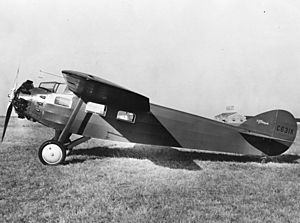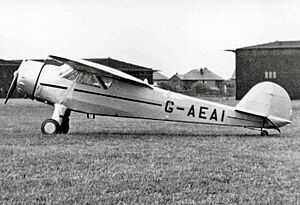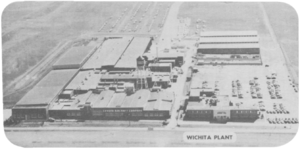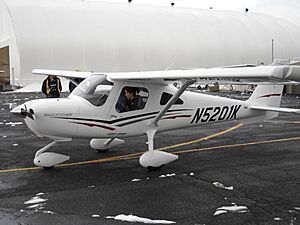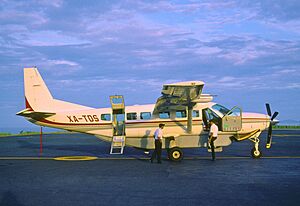Cessna facts for kids
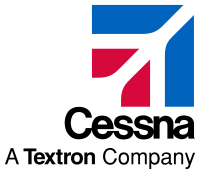 |
|
|
Formerly
|
Cessna-Roos Aircraft Company (September–October 1927) |
|---|---|
| Subsidiary | |
| Industry | Aerospace |
| Founded | September 7, 1927 |
| Founders | Clyde Cessna Victor Roos |
| Headquarters | Wichita, Kansas, United States |
|
Key people
|
Scott A. Ernest (CEO from May 31, 2011) |
| Products | List of models |
|
Number of employees
|
8,500 (2013) |
| Parent | Textron Aviation |
| Subsidiaries | McCauley Propeller Systems |
Cessna is a famous American brand that makes airplanes. It's owned by Textron Aviation and is based in Wichita, Kansas. For many years, Cessna was known as the Cessna Aircraft Company. They built many different types of planes, from small ones with piston engines to fast business jets.
Cessna was one of the biggest and most varied airplane makers in the world for a long time. It was started in 1927 by Clyde Cessna and Victor Roos. Over the years, it was bought by General Dynamics in 1985 and then by Textron in 1992. In 2014, Cessna became a brand under Textron Aviation, joining other well-known airplane companies like Beechcraft.
Cessna is especially famous for its small, high-wing planes with piston engines, especially after World War II. The Cessna 172 is their most popular plane. It has been sold since 1956, and more of them have been sold than any other aircraft in history! Cessna is also known for its Citation family of low-wing business jets, which first flew in 1969.
Contents
The Story of Cessna Aircraft
How Cessna Started Flying
Clyde Cessna was a farmer in Kansas who loved airplanes. He built his own plane and flew it in June 1911. He was the first person to fly an airplane between the Mississippi River and the Rocky Mountains! Clyde started building planes in Oklahoma. When he couldn't get more money from bankers there, he moved to Wichita.
The Cessna Aircraft Company officially began in 1927. Clyde Cessna partnered with Victor Roos to form the Cessna-Roos Aircraft Company. However, Roos left the company just one month later. His name was then removed from the company's name.
On October 29, 1929, the same day as the big stock market crash, the Cessna DC-6 plane received its official approval to fly.
In 1932, the Cessna Aircraft Company had to close down because of the Great Depression. This was a very tough time for businesses.
But Cessna didn't stay closed for long! In 1933, the Cessna CR-3 custom racer made its first flight. This plane won the 1933 American Air Race in Chicago. It also set a new world speed record, flying at an average of 237 miles per hour.
Clyde Cessna's nephews, Dwane and Dwight Wallace, bought the company from him in 1934. They reopened it and worked hard to make it a global success.
In 1937, Cessna introduced the Cessna C-37. This was their first seaplane, which means it could land on water. In 1940, Cessna got its biggest order yet. The U.S. Army ordered 33 special Cessna T-50 planes, which were Cessna's first planes with two engines. Later that year, the Royal Canadian Air Force ordered 180 more T-50s.
Growing After the War
After World War II, Cessna started making planes for regular people again in 1946. They released the Model 120 and Model 140. These new planes were made of metal and built using special tools. This was different from the older planes, which were often built by hand.
In 1948, the Model 140 was even named the "Outstanding Plane of the Year" by the US Flight Instructors Association.
Cessna's first helicopter, the Cessna CH-1, was approved for flight in 1955.
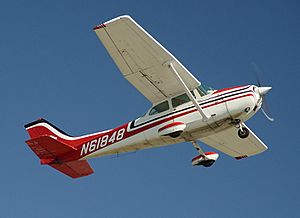
In 1956, Cessna introduced the Cessna 172. This plane became the most produced airplane in all of history! After World War II, Cessna was known as one of the "Big Three" airplane makers, along with Piper and Beechcraft.
In 1959, Cessna bought Aircraft Radio Corporation (ARC), a company that made aircraft radios. Cessna started selling these radios as "Cessna" radios for their new planes. In 1960, Cessna also bought McCauley Propeller Systems, a company that made propellers. McCauley became the world's top maker of propellers for small planes, mostly because they were used on so many Cessna aircraft.
Cessna also teamed up with Reims Aviation in France in 1960. In 1963, Cessna built its 50,000th airplane, which was a Cessna 172.
Cessna's first business jet, the Cessna Citation I, made its first flight on September 15, 1969.
By 1975, Cessna had produced its 100,000th single-engine airplane.
In 1985, Cessna was bought by General Dynamics and was no longer an independent company. General Dynamics then sold Cessna to Textron in 1992.
In late 2007, Cessna bought the Columbia Aircraft company. They continued to make the Columbia 350 and 400 planes, renaming them the Cessna 350 and Cessna 400. However, production of both these planes stopped by 2018.
Challenges and Changes
In 2007, Cessna announced that its new Cessna 162 plane would be built in China. This decision was made to save money and because Cessna's factories in the United States were full. However, many people were unhappy about this. They worried about the quality of products made in China and jobs moving overseas. This caused some public discussion for Cessna. The Cessna 162 did not sell very well, and production was eventually stopped.
Cessna faced tough times during the economic downturn from 2008 to 2010. The company had to let go of more than half of its workers during this period.
In November 2008, Textron, Cessna's parent company, said that they would make fewer Citation jets. This meant some jobs at Cessna would be lost.
Cessna's CEO, Jack Pelton, explained that sales to individual buyers had gone down. However, businesses were still buying piston and turboprop planes.
Between January 2009 and September 2010, Cessna laid off many employees. This included workers at their Wichita, Kansas, and Bend, Oregon, plants. The company also stopped the Citation Columbus jet program in 2009.
In 2010, Cessna closed three of its manufacturing places in Georgia. Some of this work was moved to Cessna's factories in Kansas or Mexico.
In 2011, Scott A. Ernest became the new CEO of Cessna.
In September 2011, the Federal Aviation Administration (FAA) suggested a large fine against Cessna. This was because the company had problems with how it made fiberglass parts at its factory in Mexico. These problems meant some parts were not strong enough. One time, a 7-foot section of a Cessna 400's wing skin came off during a test flight. Luckily, the pilot landed the plane safely.
Since 2012, Cessna has been working with a Chinese company called Aviation Industry Corporation of China (AVIC) to build business jets in China. Cessna plans to eventually make all its plane models in China.
In March 2014, Cessna officially stopped being a separate company. It became a brand under Textron Aviation, which is how it operates today.
How Cessna Talked About Its Planes
In the 1950s and 1960s, Cessna used many special marketing words to make its planes sound unique. Other airplane makers and aviation magazines sometimes made fun of these terms. However, Cessna sold more planes than any other company during those busy years.
Cessna plane names usually follow a pattern:
- 100 series: Smaller, light planes.
- 200 series: Stronger planes.
- 300 series: Light to medium twin-engine planes.
- 400 series: Planes with a wider cabin.
- 500 series: Jets.
Many Cessna models also have names that start with "C," like Citation or Caravan.
Cessna's Special Words
Here are some of the marketing terms Cessna used:
- Para-Lift Flaps – These were large flaps that Cessna added to its planes starting in 1952. They helped the planes take off and land better.
- Land-O-Matic – In 1956, Cessna introduced a new type of landing gear on the Cessna 172. This gear made it easier to land and take off. Cessna even said flying these planes was as easy as driving a car!
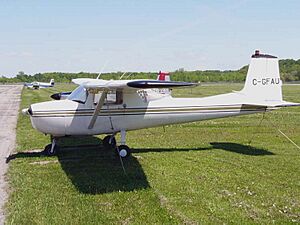
- Omni-Vision – This term described the rear windows on some Cessna planes, starting in 1962. Cessna wanted pilots to feel like they had better visibility, even though the windows didn't always help much and could slow the plane down a little.
- Cushioned Power – This referred to special rubber mounts that helped reduce vibrations from the engine in the 1967 Model 150.
- Omni-Flash – This was a flashing light on the tail of the plane that could be seen from all directions.
- Open-View – In 1967, Cessna changed the shape of its control wheels. They became "ram's horn" shaped, which meant they didn't block the instrument panel as much.
- Quick-Scan – Cessna introduced a new way of arranging the instrument panel in the 1960s. This term suggested that their panels were easy to read quickly.
- Nav-O-Matic – This was the name for Cessna's autopilot system, which was designed to be simple to use.
- Camber-Lift – Starting in 1972, Cessna added a slightly curved front edge to its wings. This term was used to describe how this design helped the plane lift.
- Stabila-Tip – Cessna often used fuel tanks on the tips of its wings. These tanks were shaped carefully to help the plane fly smoothly and stay balanced.
Cessna Airplanes Today
As of October 2020, Textron Aviation was still making these Cessna-branded planes:
- Cessna 172 Skyhawk – A high-wing plane with one piston engine and four seats. It has been made since 1956.
- Cessna 182 Skylane – Another high-wing plane with one piston engine and four seats. It has also been made since 1956.
- Cessna 206 Stationair – A high-wing plane with one piston engine and six seats, used for many purposes. It has been made since 1962.
- Cessna 208 Caravan – A high-wing plane with one turboprop engine, used for utility. It has been made since 1984.
- Cessna 408 SkyCourier – A high-wing plane with two turboprop engines, used for utility. It has been made since 2022.
- Cessna Citation family – These are twin-engine business jets.
- Cessna Citation 525 M2/CJ series – Made since 1991.
- Cessna Citation 560XL Excel – Made since 1996.
- Cessna Citation 680 Sovereign – Production stopped in 2021.
- Cessna Citation 680A Latitude – Made since 2014.
- Cessna Citation 700 Longitude – Made since 2019.
See also
 In Spanish: Cessna para niños
In Spanish: Cessna para niños


